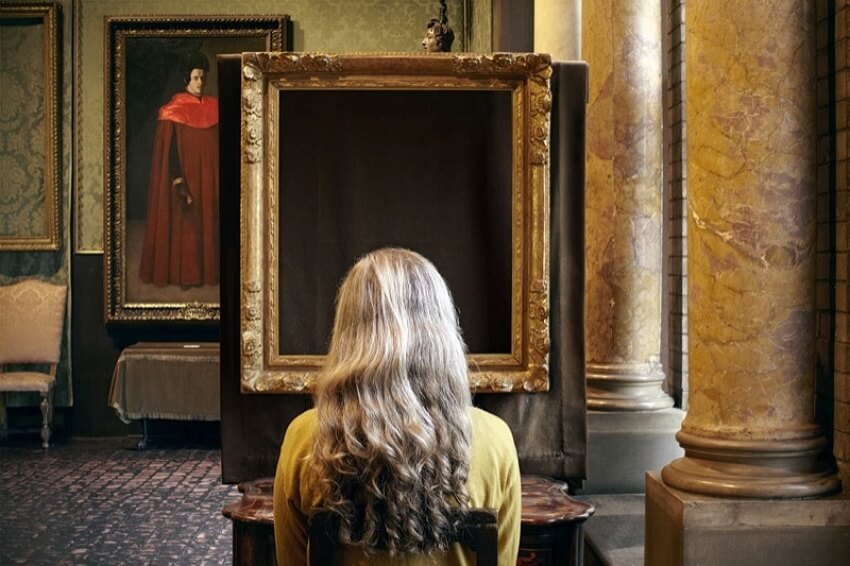The Concert Vermeer

In the annals of art history, certain paintings stand out not only for their technical brilliance but also for their ability to encapsulate the essence of human experience. One such masterpiece is “The Concert” by Johannes Vermeer, a Dutch Golden Age painter whose works are celebrated for their luminous quality and profound introspection. “The Concert” is a testament to Vermeer’s mastery, showcasing his unparalleled ability to capture the subtleties of light, color, and emotion in a single frame.
Painted circa 1664, “The Concert” is a prime example of Vermeer’s distinctive style, characterized by his meticulous attention to detail and his use of light to create a sense of depth and atmosphere. The painting depicts a scene of domestic music-making, with three figures engaged in an intimate chamber concert. A young woman seated at a harpsichord occupies the central focus of the composition, her hands poised delicately over the keys as she plays. Flanking her are two male figures: one stands at the left, holding a viola da gamba, while the other sits at the right, his back turned to the viewer as he leans forward in rapt attention.
What immediately strikes the viewer about “The Concert” is its sense of tranquility and harmony. Vermeer has captured a moment of quiet introspection, inviting the viewer to contemplate the beauty of music and the profound connections it fosters between individuals. The soft, diffused light that bathes the scene adds to its ethereal quality, suffusing the room with a gentle glow that seems to emanate from within.
One of the most remarkable aspects of “The Concert” is Vermeer’s masterful handling of color. His palette is composed of subtle shades of blue, yellow, and ochre, which he uses to create a sense of unity and coherence within the composition. The cool tones of the background recede, allowing the warm tones of the figures and the instruments to come to the forefront. This interplay of color serves to accentuate the sense of depth and spatiality in the painting, drawing the viewer into its intimate world.
Central to the composition of “The Concert” is the figure of the young woman at the harpsichord. Her graceful posture and serene expression convey a sense of concentration and poise, as she channels her emotions into her music-making. Vermeer has depicted her with remarkable realism, capturing the subtle nuances of her facial features and the delicate play of light on her skin. Her presence anchors the painting, serving as a focal point around which the other figures and elements orbit.
The two male figures in the painting, while less prominent, are no less significant. The man standing at the left, his gaze directed towards the woman at the harpsichord, exudes a sense of quiet contemplation. His instrument, the viola da gamba, rests against his shoulder, its strings poised to resonate with the music. The other man, seated at the right, is portrayed in a moment of quiet reverie, his attention fully absorbed by the music unfolding before him. Vermeer’s decision to depict him with his back turned to the viewer adds an air of mystery to his character, inviting speculation about his thoughts and emotions.
Beyond its technical virtuosity, “The Concert” is a painting rich in symbolism and allegory. Music has long been associated with transcendent experiences and spiritual enlightenment, and Vermeer’s depiction of the chamber concert is imbued with a sense of the sacred. The act of making music becomes a metaphor for the human soul’s yearning for connection and transcendence, as the figures engage in a harmonious dialogue that transcends language and cultural barriers.
The enigmatic quality of “The Concert” has inspired countless interpretations and analyses over the centuries. Some scholars have seen in it a reflection of Vermeer’s own preoccupations with the theme of artistic creation, interpreting the painting as a metaphor for the transformative power of the creative process. Others have emphasized its psychological depth, suggesting that the figures represent different aspects of the human psyche engaged in a dialogue of self-discovery and introspection.
Regardless of the specific interpretation one favors, there is no denying the enduring appeal of “The Concert” as a work of art. Its timeless beauty and profound insight into the human condition continue to captivate viewers and scholars alike, inviting us to ponder the mysteries of existence and the transcendent power of art. In an age of rapid technological advancement and social upheaval, Vermeer’s masterpiece serves as a poignant reminder of the enduring value of beauty, harmony, and human connection.
